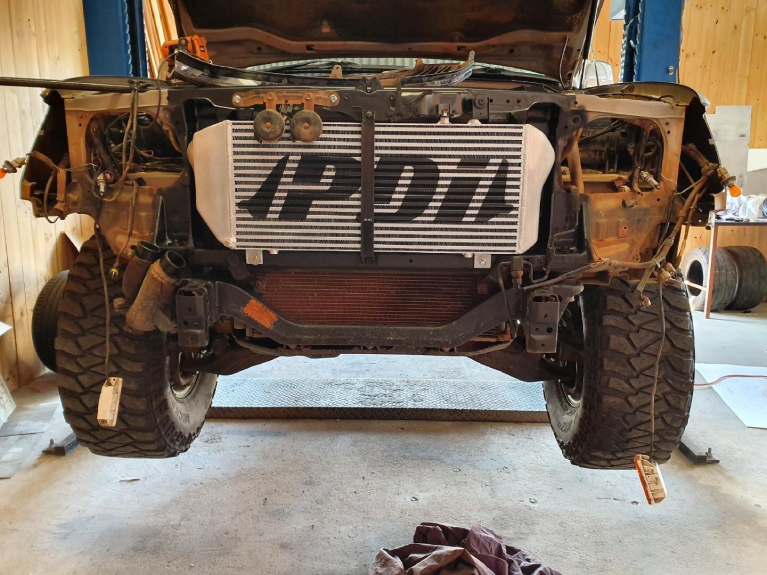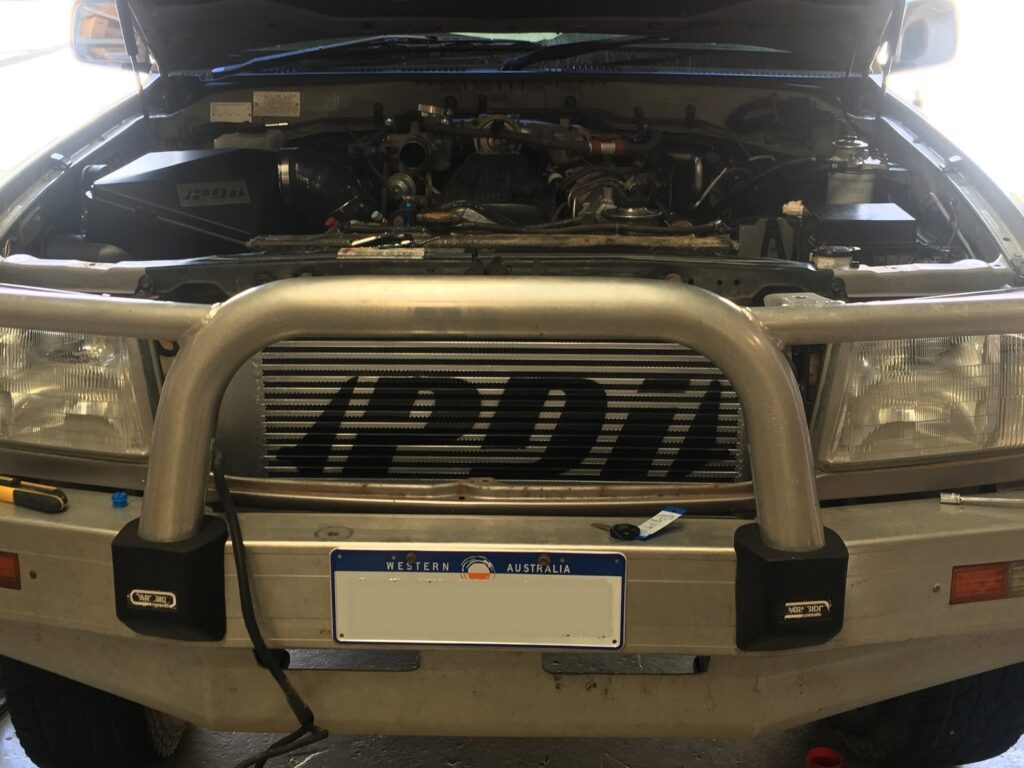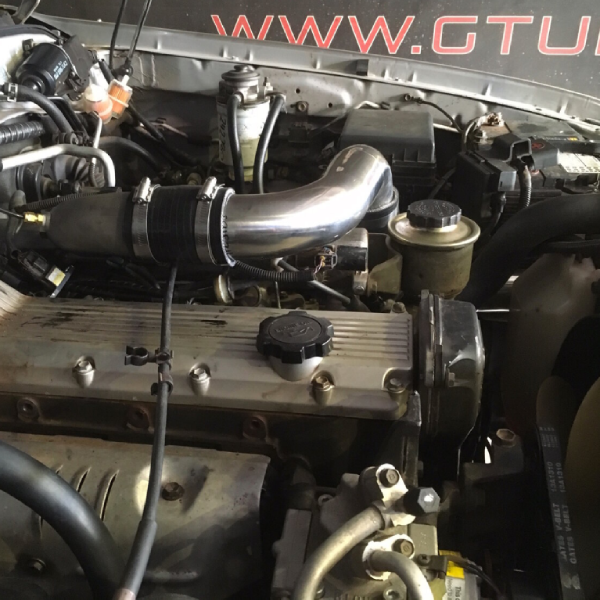Landcruiser 105 Upgrade
Trust Us with Your Landcruiser 105 Upgrade – its a favourite.
Items available on our website for 105 Series.
Front mounted intercooler kits in large core or smaller core (with attached transmission coolers for auto models).
The piping for 1HZ, 1HDT, 1HDFT, 1FZ or 1HDFTE can work with either of our 100 or 105 intercooler cores. The 100 is the larger core, which is more efficient and can handle more boost effectively. If you go the larger core you will also need to change the air con hose (between compressor and condenser) due to clearance issues. We can supply a hose (similar to the HDJ100 hose) for $80 for diesel models.
GTurbo performance turbos. The turbos are a direct bolt on using the same centre housing configuration for water and oil feed and return. The exhaust housing uses the same as all 1HD engines. The compressor cover has the same 2” outlet and the inlet can be either 3” or 3.5”, being larger than the factory size of 2 ⅞”. Three sizes are available G300, G350 and the G400, with the numbers indicating their horsepower capability (at the wheels).
- The GTurbo G300 is very responsive as its ideal for those chasing up to 20psi
- The GTurbo G350 is only slightly more laggy and suits standard or high flow injectors for those chasing a good all round turbo. Most efficient around 25psi it can be run up to 35psi successfully.
- The GTurbo G400 has very agressive power delivery while remaining good to drive (not too laggy) and is the go to turbo for those chasing 400hp at the wheels
Exchange upgraded Injectors for 1HDFTE.
Brake booster upgrades for non-ABS brake system
A442F gearbox upgrades – contact us to confirm availability but click here to learn more.
Diff gear changes. Going from the standard 4.3, you can also install, 4.1, 3.54 and 3.909 ratio gears (if going taller). Also available are shorter ratios like 4.88 if running big tyres and crawling is more important.
Torsen Mechanical LSD Differential centres – we like these are a hug improvement over the poorly designed factory rear LSD. We are also sure that these are more suitable for most customers than actual diff locks
- FZJ105 petrol powered by the 1FZ engine.
- HZJ105 diesel powered by the 1HZ naturally aspirated (non turbo).
- Both FZJ and HZJ came in different specifications. HZJ105 came in the poverty pack (commercial) model and GXL. FZJ105 was either GXL or RV spec. Customers could opt for factory diff locks and sunroof for some models.
- The GXL came with electro-hydraulic ABS brakes, central locking, electric windows, carpet and cloth seats. Also fitted with cruise control. These were also fitted with a full time transfer case.
- The RV spec combined details from the GXL and base spec. It had non-ABS brakes, GXL body with upper and lower tailgate, but manual wind up windows and central locking (controlled with dash mounted switch). Some fitted with factory diff locks.
- The poverty pack (commercial) model came with barn doors on the back, generally with vinyl flooring and vinyl seats and manual wind up windows.Braking was non-ABS
1HZ – an indirect injected 4.2L engine.
The injection pump has a 10mm plunger and has enough fuel to make just over 130kw at wheels once suitably turbocharged and intercooled.
While it has been proved you can get a lot more power from the old 1HZ just by adding more fuel and air, the head will flow the air and exhaust gases, but its cooling system water jacket is far from acceptable in these conditions. This might be a good for short circuit work but when towing the steam forming in the head creates in insulator so that the steel cannot be cooled. This results in hot spots and uneven heating across the head and will end up with cracking.
If rebuilding a 1HZ, consider that high combustion temperatures (detected in Exhaust Gas Temperatures) is what will kill your engine and rarely is it boost. For us this means it is important you get quality pistons (genuine) and maybe consider a ceramic coating if you are sure it will work. Upgrading conrods to “turbo spec” might be a good idea if planning to run +20psi boost, but is it rare to hear of a turbo 1HZ breaking a corned.
https://www.engine-specs.net/toyota/1hz.html
1FZ – fuel injected 4.5L engine. Known for being strong and reliable, but not fuel efficient.
With a turbocharger added and the correct fuel control, these can produce amazing torque and power figures.
https://www.engine-specs.net/toyota/1fz-fe.html
1FZ – fuel injected 4.5L engine. Known for being strong and reliable, but not fuel efficient.
With a turbocharger added and the correct fuel control, these can produce amazing torque and power figures.
https://www.engine-specs.net/toyota/1fz-fe.html
All 105 were fitted with 4.3 ratio (43:10) diff gears.
R151 manual in the HZJ105 – affectionately referred to as the Hilux box and is the weakest box fitted to a Landcruiser. The input and output shaft sizes are different to the larger H151 gearbox. In the HZJ105 it has 2 different casing designs which the GXL model having the shifter further back and the poverty pack being further forward. If you have the poverty pack then the 80 series and 79 series have the shifter in the same location. If you have a GXL and want the stronger gearbox then you will need to get one from a FZj105 or HDJ100 (both GXL).
H151 manual in the FZJ105 – the stronger manual transmission and has slightly different 2nd gear ratio than the HDJ100 gearbox.
A442F 4 speed auto in in FZJ105 – cable line pressure control and shift points determined by main engine ECU using inputs of throttle position and speed.
A442F 4 speed auto in in HZJ105 – cable line pressure control and shift points determined by transmission ECU (located above drivers left foot) using inputs of throttle position and speed.
Boost the performance of your vehicle with a Landcruiser 105 upgrade. At Performance Diesel Intercoolers , we stock a wide range of products for your HZJ105 upgrade. From intercoolers, airboxes, MAP sensor filters to diff ratio crown wheel and pinion sets, there is a product suitable for your requirements.
Intercooling the 1HZ.
For the basic level of upgrade, people have the HZJ105 non turbo engine 40-50kW at wheels and look to bolt on a turbo to double the power (75-80kW at wheels). Next, need to consider an intercooler for power (110-130kW at wheels) as well as to drop EGT.
High combustion temperatures are really the only thing that kills the 1HZ so effort should be made to tune to keep them under control as well as monitor EGT with a gauge or display – PDI have a well price digital display EGT.
We once had the idea that while our front mounts are very good at dropping heat, for low boost levels a small top mount would be sufficient. This was dispelled soon after, as we had this setup on the dyno. It produced less power than with a PDI front mount (due to tuning with air fuel ratios AND a quick check on the outlet temperatures showed it wasn’t doing very much. We would always recommend a front mount with the 1HZ if you ever load it up.
1HDFTE Engine swaps.
Many ways to do this, but doing it right is the important. Installing the engine management system is the part that must be done right for reliability, but deciding what the objectives are very important so the correct parts can be chosen.
We have done this conversion many times and have helped lots to complete their builds with advise and parts. Working out the power objectives or if you will be towing or want auto/manual transmission is a good place to start. Possibly starting with another body is also worth considering for a cost effective build.
The 1HD-FTE from the HDJ100 put down between 105-110kW at the wheels and the same engine from the HDJ79 puts down around90kW at the wheels. The ECU plugs and intake butterfly for the HDJ79 is the same as the 1998 – mid 2002 HDJ100. The later model (mid 2002 – 2006) HDJ100 came with the electronic butterfly and different ECU.
Once modified the HDJ79 and late model HDJ100 will respond the best. The early HDJ100 will typically result the least amount of power (by 20-30kW) so this needs to be taken into account when purchasing and what mods to perform for getting best results.
1HDFTE engine upgrades.
From standard normally the first thing done is a chip/module as it is not possible to reflash or reprogram the ECU.
After this it is to increase boost and consider a upgraded turbo or intercooler. Depending on the intended use you may want to do one before the other or both at the same time.

Engine Swaps.
The most common swap is to install the Toyota factory turbo engines, being 1HD-T, 1HD-FT (from 80 series) and the most popular 1HD-FTE (from the HDJ100 series or HDJ79). The 1HDF-T may pass emissions requirements for the very first of the 105 series, but the 1HD-FTE with electronic fuel pump is the only one that is from the same generation and will pass Department of Transport approvals.
Other conversion options are a V8 diesel, but these deviate from the design too much and will not compare to power output, given money spent to a modified 1HD engine.
There are a range of other conversions that are done including the Barra turbo engine from the Falcon.
1HDFTE Upgrade Limitations
A750 5 speed auto 160kW at wheels with modified valve body – this means standard injectors or maybe +30 if you trust the tuner to control torque to keep it under 600Nm.
A442F 4 speed auto 240kW at wheels with modified valve body. Can also run high flow injectors with this transmission and over 30psi boost. We still think there is more capability on these.
H151 5 speed manual. With standard clutch limited to standard injectors and 25psi boost. With a suitable clutch (NPC 1300Nm) these boxes can handle up to 300kW at the wheels with some reliability. Above this power or if not driven nicely the gearbox will
R151 5 speed manual – if you want to run this box with a turbo engine then you are taking a risk, so drive easy and don’t load up in 5th gear. When upgrading consider finding a H151 replacement.
PDI 6R80 6 speed auto conversion – strong enough to handle the power potential of a fully modified 1HDFTE or turbo 1FZ.
What You Should Know About a Brake Booster
- An effective brake booster is a critical component to the braking and appears as a black, circular canister located on the firewall, between the pedal and master cylinder. Together with the master cylinder, it works at stopping the vehicle with less force applied by the driver.
- Brake boosters are available in single and dual diaphragms. Once the driver steps on the pedal it multiplies the force exerted to the main brake cylinder resulting the piston pushing braking fluid through the system. The liquid pressure increases and fluid moves to the slave cylinder at the wheels where it clasps the brake rotors’ pads, slowing down the car.
- PDI brake boosters are larger than factory (and other aftermarket options) so that the force able to be applied on the master cylinder is increase (up to 50% more) so that stopping ability is increased.
- Ultimately, an upgraded PDI brake booster massively changes the results when emergency stopping is required or when the vehicle is fully loaded or running larger diameter tyres. The standard brake booster means the driver would have to apply more pressure to the pedal to try and slow the vehicle down – often not enough assistance is available from the standard booster to achieve satisfactory stopping so driving style needs to change.


About Performance Diesel Intercoolers
We are the result of trying to get the most out of intercoolers for our vehicles and after years of testing, established our efficient brand. Moreover, we designed our kits for high load situations and increased performance in conjunction with other modifications.
Contact us for upgrades to your vehicle.
